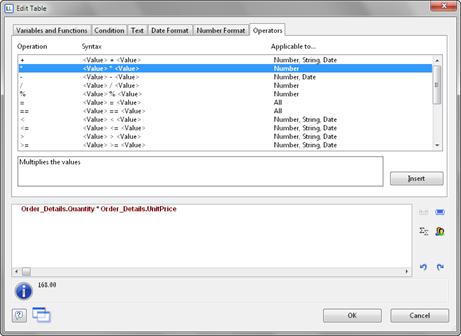Open the list of available operators by clicking the "Operators" tab. The operators are used to join variables and free text to give more complex conditions and to perform compares or calculations.
On the "Operators" tab, you will find the respective operators in the column on the extreme left; the syntax is shown in the middle column and the value types with which the respective operator can be used in the right column.
Operators join two or more values or variables to give a new value. In this way, you can formulate arithmetic expressions (basic arithmetic operations) or logical expressions. The value type of the result of an expression depends on the value type of the individual elements of the expression.
The "+" operator has a special meaning. It is not only used for additions ("Number" and "Date" (value types) but also for joining strings and fixed text ("string" value type).
You can combine multiple operations in one expression. The normal rules of precedence apply in this case: Logical operators are evaluated before arithmetic operators which are evaluated before relational operators. You must use brackets if you want a different processing order. The "innermost" brackets are evaluated first.
The general processing hierarchy is
|
Priority |
Operator |
|
1 |
brackets () |
|
2 |
functions |
|
3 |
logical operators |
|
4 |
arithmetic operators |
|
5 |
relational operators |

Figure 10.14: Example of multiplying two fields
See also:


